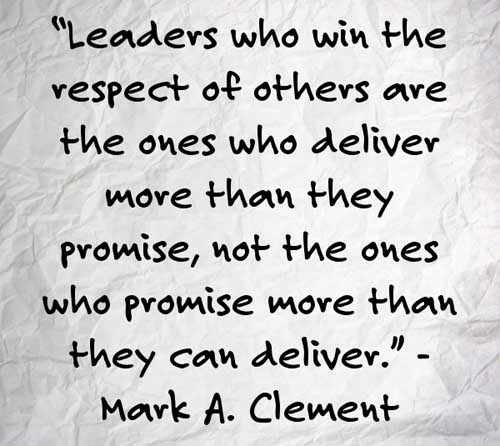Success Advice
The 7 Habits Of Highly Respected People
We all have role models– people we admire and strive to emulate.
Steve Jobs, Richard Branson, Oprah Winfrey, Tony Robbins…What sets them apart? After all, they’re just human like everyone else right?
They’ve cultivated the right habits. And we can do exactly the same.
Respect is earned, not demanded.
Here are 7 habits of highly respected people:
1. Acknowledge
Highly respected people enter a room and acknowledge each person in close proximity, not just those in their ‘click.’ They don’t shake hands with one or two and give a head nod to the rest. They take time smile and look at every person in the eye.
Try that next time you attend an event. Acknowledge, look them in the eye, and give a warm smile.
2. Live In The Background
Highly respected people don’t chase after the spotlight. They do the work because they believe in it. They add value to others and contribute to the world even if their efforts go unnoticed. Intrinsic value is found in doing the work. They can smile and be at peace when they lay their heads down at night.
Do what you do because you believe in it, not for fifteen minutes of fame.
3. Appreciation
Taking time out to send a thank you email or writing a short note. Highly respected people extend gratitude and appreciate the efforts of others. While their work may go unnoticed, they make sure the efforts of others do not. They know that a simple thank you can brighten up someone’s day.
It doesn’t take much time to pass a little thank you note to someone. And There’s never a shortage of people that we can be thankful for.
4. The Shirt Off Their Back
Sharing is not only caring, but respected. Highly respected people have a mindset of giving and generosity. They recognise that their life has been enriched through the generosity of others and are constantly “paying it forward.” They understand that you reap what you sow, that the good life is a two-way street.
Simon Sinek’s book, Leader’s Eat Last was inspired by his time observing the Marines. In the Marines, the officers eat last. Indeed the camaraderie and bond within the Marines is unmatched for this very reason. The powerful culture is built off the virtue of selflessness.
You can create that very culture by practicing a simple act of generosity today. Try it. Pay for someone’s lunch or dinner.
5. The Bottom Up
Getting in the trenches with everyone else. The highly respected person doesn’t see themselves above everyone else. If they see trash, they simply pick it up rather than call the janitor.
Guy Kawasaki in his Ted Talk points out that Steve Jobs did demos on Apple’s products. He was not only the mind behind the innovations but also the hands that operated them. He knew the business from the bottom up. He didn’t live in an ivory tower.
Whatever context you are involved with, don’t be afraid of getting your hands dirty.
6. Bigger Than Themselves
Highly respected people have goals and a mission in life that extends beyond themselves. They seek corporate profit, not merely individual profit. They want victory, but shared victory; Striving to change their life, so they can change others.
Set goals that bring about more than self-gratification. Think in terms of legacy and impact. Be blessed so that you can be a blessing. Work for abundance so that you may give abundantly.
7. Let Actions Do The Talking
They don’t make empty promises, but deliver every time. Highly respected people turn up and get the job done, and then talk about it later, if ever. They’re never late. They’re more walk and less talk. They’d rather show than tell. They understand that eloquent speech and fancy pitches are pointless without actions.
Do you have an action plan to go with your great idea?
Begin to cultivate these habits and earn the respect of the people around you today. With respect comes trust. That combination allows you to make a tremendous impact on somebody’s life.

Did You Know
How Skilled Migrants Are Building Successful Careers After Moving Countries
Behind every successful skilled migrant career is a mix of resilience, strategy, and navigating systems built for locals.

Moving to a new country for work is exciting, but it can also be unnerving. Skilled migrants leave behind familiar systems, networks, and support to pursue better job opportunities and a better future for their families. (more…)
Life
10 Research-Backed Steps to Create Real Change This New Year
This New Year could finally be the one where you break old patterns and create real, lasting change.

Every New Year, we make plans and set goals, but often repeat old patterns. (more…)
Change Your Mindset
The Silent Skill That Makes People Respect You Instantly
What truly earns respect and why most people go about it the wrong way

Everybody craves respect but not everyone earns it. Some people believe that a title, years of experience, or a position of authority automatically entitles them to respect. (more…)
Entrepreneurs
The Essential Skills Every Entrepreneur Needs In 2026
Success in the digital age isn’t about luck. It’s about mastering the skills that separate dreamers from doers.

When I was 22 years old, I started my first side hustle as a ghostwriter. (more…)
-

 Shift Your Mindset4 weeks ago
Shift Your Mindset4 weeks ago11 E’s That Define Every Great Leader And Why Most People Miss Them
-

 Did You Know3 weeks ago
Did You Know3 weeks agoThe Success Patterns You Inherited (And Didn’t Notice)
-

 Entrepreneurs3 weeks ago
Entrepreneurs3 weeks agoThe Essential Skills Every Entrepreneur Needs In 2026
-

 Business4 weeks ago
Business4 weeks agoThe Hidden Money Pit in Your Operations (and How to Use It)
-

 Change Your Mindset2 weeks ago
Change Your Mindset2 weeks agoHow to Turn Your Mind Into Your Greatest Asset (Instead of Your Enemy)
-

 Change Your Mindset2 weeks ago
Change Your Mindset2 weeks agoThe Silent Skill That Makes People Respect You Instantly
-

 Life1 week ago
Life1 week ago10 Research-Backed Steps to Create Real Change This New Year
-

 Tech1 week ago
Tech1 week agoWhat’s in a Name? How to Get Your Domain Right


























9 Comments